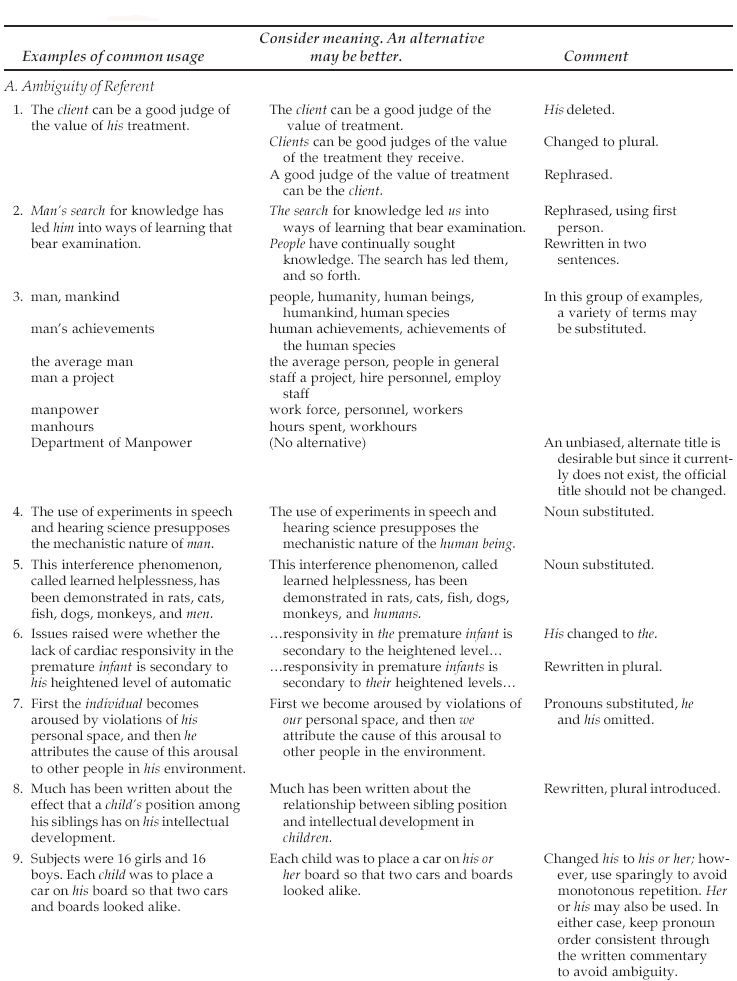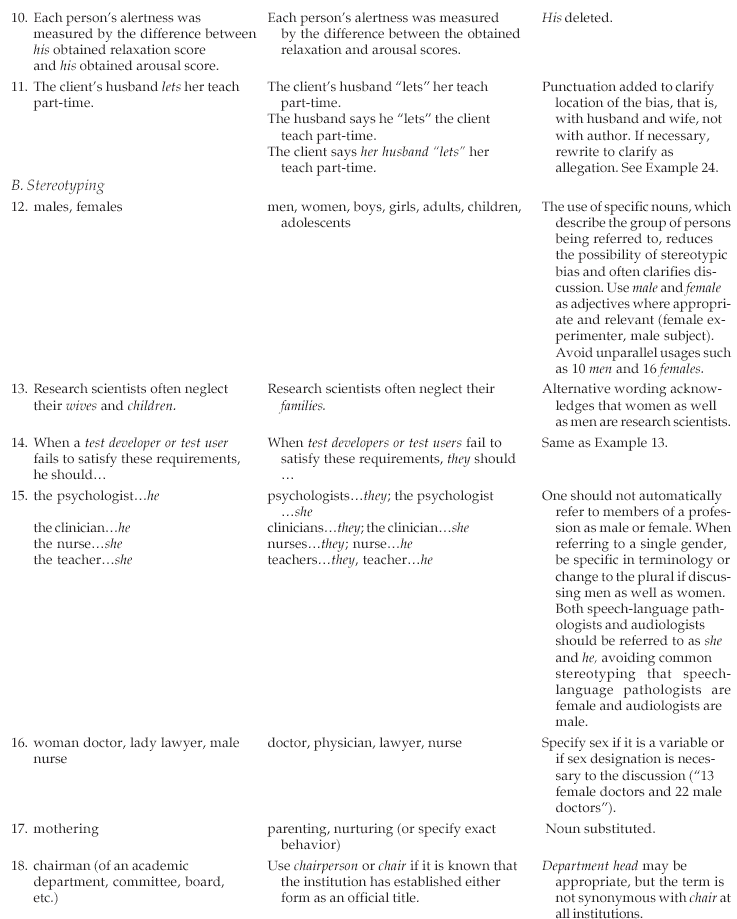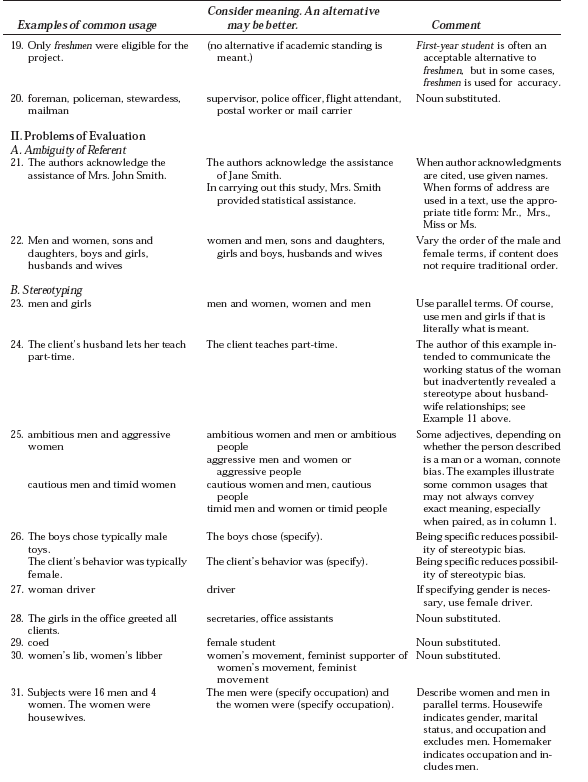Gender Equality in Language Use
Guidelines
Committee on Equality of the Sexes in the Professions
About this Document
These guidelines are an official statement of the American Speech-Language-Hearing Association (ASHA). They provide guidance on the procedures for preparing documents, but are not official standards of the Association. They were developed by the ASHA Committee on Equality of the Sexes in the Professions: Jan J. Binney, Ken J. Kallail, Sr. Marie A. Kopin, Frances O. Pappas, Nevis C. Phillips, Cynthia M. Shewan (ex officio), Roberta Wacker-Mundy, and Christine C. Sleight (chair). Judith K. Montgomery, vice president for administration and planning, was the monitoring vice-president. The 1992 guidelines supersede the guidelines titled “Guidelines for Nonsexist Language in Journals of ASHA,” Asha, November 1979, pages 973–978.
Introduction
The American Speech-Language-Hearing Association (ASHA) endorses the use of language that promotes gender equality. ASHA does not condone written commentary that intentionally or unintentionally uses biased or discriminatory gender terms. ASHA as a publisher accepts author's word choices unless those choices are inaccurate, unclear, or ungrammatical. Additionally, because ASHA as an organization is committed to the nondiscriminatory treatment of individuals and groups, authors are expected to use wording in their writing that promotes gender equality.
ASHA supports the use of language that deals with gender in a fair and impartial manner. Appropriate usage includes being specific about gender when inclusion of this information is relevant, and avoiding generalizations, which may lead to stereotyping. The following guidelines on gender equality in language use are intended to help authors recognize and change instances where word choices may be inaccurate, misleading, or discriminatory.
Problems of gender equality in writing may be classified into two categories that are conceptually different: problems of designation and problems of evaluation.
Problems of Designation
An author must use care in choosing words to ensure accuracy, clarity, and freedom from bias. Nouns, pronouns, and adjectives that designate persons can be chosen to eliminate, or at least to minimize, the possibility of ambiguity in gender identity or role. In the following examples, problems of designation are divided into two subcategories: ambiguity of referent, where it is unclear whether the author means male or female, and stereotyping, where the writing conveys unsupported or biased connotations about gender roles and identity.



Problems of Evaluation
By definition, written commentary should be clear and precise, in other words, avoid ambiguity of wording. Phrases that are commonly used but that include implied or irrelevant evaluation of the sexes are inappropriate to written commentary. An often-used expression, such as “man and wife,” implies differences in the freedoms and activities of each person. Because the terms in this phrase are not parallel, preferable alternatives are “husband and wife” or “wife and husband.” In the examples that follow, problems of evaluation, like problems of designation, are divided into ambiguity of referent and stereotyping.
A Final Word
Using gender-equitable language improves communication. Authors who make clear which gender is under discussion communicate clearly to the reader. Although some aspects of our language that may be considered gender-biased are firmly embedded in our culture, rephrasing and careful attention to meaning can result in accurate, unbiased communication. The purpose of these guidelines is to foster communication that is balanced, fair, and impartial relative to gender.
With reference to the work of the Committee on Equality of the Sexes in the Professions, Sleight noted “As specialists in communication disorders [speech-language pathologists and audiologists], we are all aware that the language we hear, read, and see shapes our experience. Creating equality in language form leads to equality in language function. It is the Committee's hope that this will, in turn, lead to gender equality in all aspects of the professional[s]…” (1990).
Suggested Reading
APA Task Force on Issues of Sexual Bias in Graduate Education. (1975). Guidelines for nonsexist use of language. American Psychologist, 30, 682–684.
Burr, E., Dunn, S., & Farquhar, N. (1976). Guidelines for equal treatment of the sexes in social studies textbooks (Available from Westside Women's Committee, P.O. Box 24D20, Los Angeles, CA 90024).
DeBoard, D., Fisher, A. M., Moran, M. C., & Zawodny, L. Guidelines to promote the awareness of human potential (undated). Philadelphia, Lippincott.
Harper & Row. (1976). Harper & Row guidelines on equal treatment of the sexes in textbooks. New York: Author.
Henley, N., & Thorne, B. (1975). She said/he said: An annotated bibliography of sex differences in language, speech, and nonverbal communication (Available from Know, Inc., P.O. Box 86031, Pittsburgh, PA 15221).
Hill, A. O. (1986). Mother tongue, father time. Bloomington: Indiana University Press.
Holt, Rinehart. Winston (College Department). (1976). The treatment of sex roles and minorities. New York: Author.
Hyde, J. S. (1984). Children's understanding of sexist language. Developmental Psychology, 20(4), 697–706.
Janssen-Jurreit, M. (1982). Sexism: The malt monopoly on history and thought. New York: Farrar Straus Giroux.
Lakoff, R. (1975). Language and woman's place. In New York: Harper & Row.
Lerner, H. E. (1976). Girls, ladies, or women? The unconscious dynamics of language choice. Comprehensive Psychiatry, 17, 295–299.
McGraw-Hill. Guidelines for equal treatment of sexes in McGraw-Hill Book Company publications (undated). New York: Author.
Miller, C., & Swift, K. (1976). Words and women. Garden City, NY: Anchor Press/Doubleday.
Penelope, J. (1990). Speaking freely. New York: Pergamon Press.
Prentice-Hall. (1975). Prentice-Hall author's guide (5th ed.). Englewood Cliffs, NJ: Author.
Random House. (1975). Guidelines for multiethnic/nonsexist survey. New York: Author.
Scott, Foresman. (1974). Guidelines for improving the image of women in textbooks. Glenview, IL: Author.
Sleight, C. C. (1990). Gender matters in the university: Challenges and opportunities. In Ripich, D. N., McClelland, W. D., & Wilcox, K. (Eds.). Proceedings of the Eleventh Annual Conference on Graduate Education. (pp. 95-111), Tampa, FL: Council of Graduate Programs in Communication Sciences and Disorders.
Sleight, C. C., Kallail, K., Kopin, M., Lynch, J. I., Shaughnessy-DuChane, A., & Venus, C. A. (1968, June/July). Women's issues: An annotated bibliography. Asha, 47–48.
Tannen, D. (1990). You just don't understand. New York: Ballantine Books.
John Wiley & Sons. (1977). Wiley guidelines on sexism in language. New York: Author.
Acknowledgment
The ASHA Committee on Equality of the Sexes in the Professions developed these guidelines by modifying the Guidelines for Nonsexist Language in APA Journals prepared by the APA Publication Manual Task Force. (American Psychologist, June 1977).
Index terms: language, gender
Reference this material as: American Speech-Language-Hearing Association. (1993). Gender equality in language use [Guidelines]. Available from www.asha.org/policy.
© Copyright 1993 American Speech-Language-Hearing Association. All rights reserved.
Disclaimer: The American Speech-Language-Hearing Association disclaims any liability to any party for the accuracy, completeness, or availability of these documents, or for any damages arising out of the use of the documents and any information they contain.
doi:10.1044/policy.GL1993-00200











